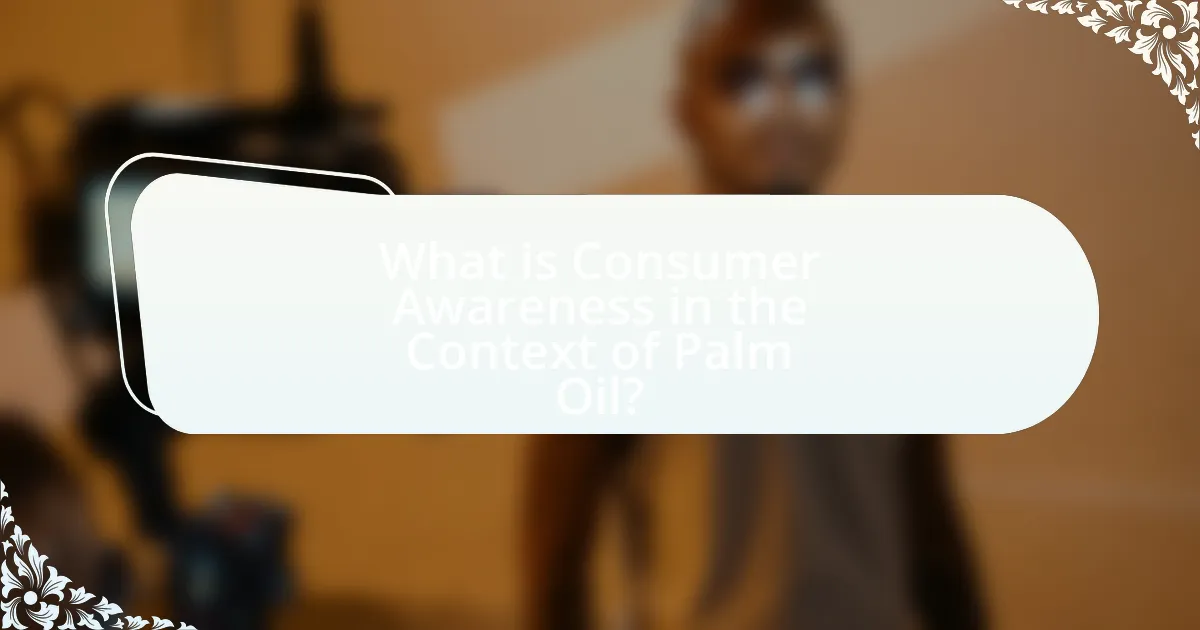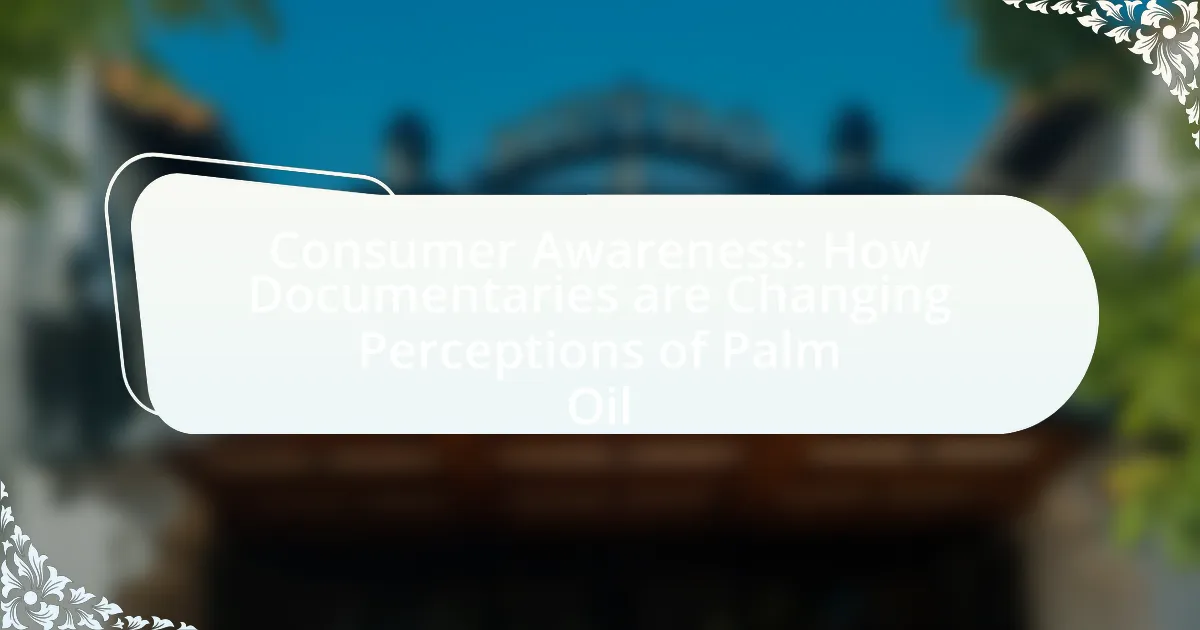Consumer awareness regarding palm oil encompasses the understanding of its environmental, social, and health impacts, significantly shaped by documentaries that expose issues like deforestation and human rights violations. These films effectively raise awareness and influence consumer behavior by presenting factual information and emotional narratives. Key themes include environmental degradation, social justice, and consumer responsibility, which resonate with the growing demand for sustainable practices. The article explores how documentaries drive change in consumer perceptions and industry practices, the challenges they face in combating misinformation, and practical steps consumers can take to make informed choices about palm oil.

What is Consumer Awareness in the Context of Palm Oil?
Consumer awareness in the context of palm oil refers to the understanding and knowledge that consumers possess regarding the environmental, social, and health impacts associated with palm oil production and consumption. This awareness has been significantly influenced by documentaries that highlight issues such as deforestation, habitat destruction, and human rights violations linked to palm oil plantations. For instance, research indicates that documentaries can effectively raise awareness and alter consumer behavior by providing factual information about the consequences of palm oil sourcing, leading to more informed purchasing decisions.
How do documentaries influence consumer awareness about palm oil?
Documentaries influence consumer awareness about palm oil by providing in-depth information on its environmental and social impacts. These visual narratives often highlight the deforestation, habitat destruction, and human rights abuses associated with palm oil production, prompting viewers to reconsider their purchasing choices. For instance, the documentary “Before the Flood” showcases the detrimental effects of palm oil on biodiversity and climate change, leading to increased public discourse and concern. Research indicates that exposure to such documentaries can significantly raise awareness and alter consumer behavior, as evidenced by a study published in the journal “Environmental Communication,” which found that viewers of environmental documentaries were more likely to support sustainable practices and products.
What are the key themes presented in documentaries about palm oil?
Key themes presented in documentaries about palm oil include environmental degradation, social justice, and consumer responsibility. Documentaries often highlight the deforestation caused by palm oil plantations, which leads to loss of biodiversity and contributes to climate change. For instance, the documentary “Before the Flood” emphasizes the impact of palm oil production on tropical forests and wildlife habitats. Additionally, social justice themes are prevalent, showcasing the exploitation of workers and indigenous communities affected by palm oil cultivation. Documentaries like “The True Cost of Palm Oil” illustrate these human rights issues, urging viewers to consider the ethical implications of their consumption choices. Lastly, consumer responsibility is a recurring theme, with filmmakers advocating for sustainable palm oil practices and encouraging viewers to make informed purchasing decisions. This is supported by initiatives like the Roundtable on Sustainable Palm Oil, which aims to promote sustainable production methods.
How do these themes resonate with consumers’ values?
Themes related to sustainability and ethical consumption resonate strongly with consumers’ values, particularly in the context of palm oil awareness. Documentaries highlighting the environmental impact of palm oil production align with the growing consumer demand for transparency and responsible sourcing. For instance, a 2021 survey by Nielsen found that 73% of global consumers are willing to change their consumption habits to reduce environmental impact, indicating a significant shift towards valuing sustainability. This alignment between documentary themes and consumer values fosters a more informed public, encouraging ethical purchasing decisions that prioritize ecological and social responsibility.
Why is consumer awareness important for palm oil sustainability?
Consumer awareness is crucial for palm oil sustainability because it drives informed purchasing decisions that can influence industry practices. When consumers are educated about the environmental and social impacts of palm oil production, they are more likely to choose sustainably sourced products, thereby encouraging companies to adopt responsible sourcing policies. For instance, a study by the World Wildlife Fund found that consumer demand for sustainable palm oil has led to a 50% increase in the area of certified sustainable palm oil production between 2013 and 2018. This shift not only helps protect biodiversity but also supports local communities by promoting ethical labor practices.
What role does consumer demand play in palm oil production practices?
Consumer demand significantly influences palm oil production practices by driving the need for sustainable sourcing and ethical practices. As consumers become more aware of the environmental and social impacts of palm oil, they increasingly prefer products that are certified sustainable, such as those endorsed by the Roundtable on Sustainable Palm Oil (RSPO). This shift in consumer preference has led companies to adopt more responsible sourcing policies, implement traceability measures, and invest in sustainable agricultural practices to meet market expectations. For instance, a report by the World Wildlife Fund indicates that brands responding to consumer demand for sustainability have committed to zero deforestation policies, thereby reshaping production practices in the palm oil industry.
How can informed consumers drive change in the palm oil industry?
Informed consumers can drive change in the palm oil industry by making conscious purchasing decisions that favor sustainably sourced products. When consumers choose products certified by organizations like the Roundtable on Sustainable Palm Oil (RSPO), they signal to manufacturers the demand for ethical practices. This consumer behavior can lead to increased pressure on companies to adopt sustainable sourcing policies, as evidenced by a 2018 study from the World Wildlife Fund, which found that brands responding to consumer demand for sustainability saw a 30% increase in sales of certified products. By leveraging their purchasing power, informed consumers can influence market trends and encourage transparency in the palm oil supply chain.

How are Documentaries Shaping Perceptions of Palm Oil?
Documentaries are shaping perceptions of palm oil by highlighting its environmental and social impacts, thereby influencing consumer awareness and behavior. For instance, films like “Palm Oil: The New Gold” and “Before the Flood” expose the deforestation and habitat destruction linked to palm oil production, leading viewers to reconsider their purchasing choices. Research indicates that documentaries can significantly increase public knowledge and concern about sustainability issues, with a study published in the journal “Environmental Communication” showing that viewers of environmental documentaries are more likely to engage in pro-environmental behaviors. This shift in perception can drive demand for sustainable palm oil alternatives, ultimately impacting industry practices.
What storytelling techniques do documentaries use to convey messages about palm oil?
Documentaries use various storytelling techniques to convey messages about palm oil, including personal narratives, visual imagery, expert interviews, and statistical data. Personal narratives often feature individuals affected by palm oil production, creating emotional connections that highlight the human impact of the industry. Visual imagery, such as footage of deforestation and wildlife displacement, serves to illustrate the environmental consequences of palm oil cultivation. Expert interviews provide authoritative insights, lending credibility to the documentary’s claims and educating viewers on the complexities of the issue. Additionally, the use of statistical data, such as the percentage of deforestation attributed to palm oil, reinforces the urgency of the message and informs the audience about the scale of the problem. These techniques collectively enhance viewer engagement and promote awareness about the implications of palm oil consumption.
How do visuals and narratives impact viewer perceptions?
Visuals and narratives significantly shape viewer perceptions by influencing emotional responses and cognitive engagement. Research indicates that compelling visuals can evoke strong emotional reactions, which in turn affect how viewers interpret information. For instance, a study published in the journal “Media Psychology” by Nabi and Krcmar (2004) found that emotionally charged images can enhance the persuasive impact of narratives, leading to increased viewer empathy and understanding. Additionally, narratives that incorporate relatable characters and storytelling elements can create a sense of connection, making the information more memorable and impactful. This is particularly relevant in documentaries about palm oil, where visuals of deforestation and wildlife can evoke concern, prompting viewers to reconsider their consumption choices.
What emotional responses do these documentaries aim to evoke?
These documentaries aim to evoke emotional responses such as empathy, outrage, and concern regarding the environmental and social impacts of palm oil production. By showcasing the destruction of rainforests, the displacement of indigenous communities, and the suffering of wildlife, these films create a visceral connection that prompts viewers to reflect on their consumption choices. For instance, documentaries like “Before the Flood” highlight the urgency of climate change and its link to palm oil, effectively stirring feelings of responsibility and a desire for change among audiences.
What are some notable documentaries focused on palm oil?
Notable documentaries focused on palm oil include “The True Cost of Palm Oil,” which explores the environmental and social impacts of palm oil production, and “Before the Flood,” featuring Leonardo DiCaprio, which addresses climate change and includes discussions on palm oil’s role in deforestation. Another significant documentary is “Our Planet,” narrated by David Attenborough, highlighting the consequences of palm oil cultivation on biodiversity. These documentaries provide critical insights into the ethical and ecological issues surrounding palm oil, raising consumer awareness and prompting discussions on sustainable practices.
How do these documentaries differ in their approach and message?
The documentaries differ in their approach and message by utilizing distinct narrative styles and focal points to convey their perspectives on palm oil consumption. For instance, one documentary may adopt a personal storytelling approach, featuring individual testimonials to evoke emotional responses and highlight the human impact of palm oil production. In contrast, another documentary might employ a more analytical style, presenting statistical data and expert interviews to emphasize environmental consequences and economic implications. This variation in narrative technique shapes the overall message, with some documentaries aiming to inspire immediate consumer action, while others focus on educating the audience about systemic issues related to palm oil.
What impact have these documentaries had on public discourse about palm oil?
Documentaries about palm oil have significantly influenced public discourse by raising awareness of the environmental and social issues associated with its production. These films have highlighted deforestation, habitat destruction, and human rights abuses linked to palm oil cultivation, prompting consumers to reconsider their purchasing choices. For instance, the documentary “Before the Flood” showcases the detrimental effects of palm oil on biodiversity, leading to increased public scrutiny and calls for sustainable sourcing practices. As a result, many companies have begun to adopt more transparent supply chains and commit to using sustainably sourced palm oil, reflecting a shift in consumer expectations and corporate responsibility.

What Challenges Do Documentaries Face in Raising Consumer Awareness?
Documentaries face significant challenges in raising consumer awareness, primarily due to issues of accessibility, viewer engagement, and misinformation. Accessibility is a major hurdle, as many consumers may not have the time or resources to watch documentaries, limiting their exposure to critical information about topics like palm oil. Viewer engagement is another challenge; documentaries often struggle to captivate audiences, leading to reduced retention of important messages. Furthermore, misinformation proliferates in the digital age, making it difficult for documentaries to counteract false narratives effectively. For instance, a study by the Pew Research Center found that 64% of Americans believe misinformation is a major problem, which complicates the efforts of documentaries to inform and educate consumers accurately.
How do misinformation and skepticism affect consumer perceptions of palm oil?
Misinformation and skepticism significantly distort consumer perceptions of palm oil by fostering negative associations and distrust. Studies indicate that misleading information about the environmental impact of palm oil, such as claims of deforestation and habitat destruction, leads consumers to view palm oil as an unethical choice. For instance, a survey by the World Wildlife Fund found that 66% of consumers are concerned about the environmental effects of palm oil, largely due to misinformation. This skepticism can result in decreased demand for palm oil products, as consumers opt for alternatives perceived as more sustainable.
What strategies can documentaries employ to combat misinformation?
Documentaries can combat misinformation by employing fact-checking, expert interviews, and transparent sourcing of information. Fact-checking ensures that the content presented is accurate and reliable, which helps to counter false narratives. Expert interviews provide authoritative perspectives that lend credibility to the documentary’s claims, as seen in the documentary “Before the Flood,” which features scientists and activists discussing climate change and its impacts. Transparent sourcing allows viewers to verify the information presented, fostering trust and encouraging critical thinking. By utilizing these strategies, documentaries can effectively challenge and correct misinformation surrounding topics like palm oil and its environmental implications.
How can filmmakers ensure credibility in their narratives?
Filmmakers can ensure credibility in their narratives by conducting thorough research and presenting factual information. This involves verifying data from reliable sources, such as scientific studies or expert interviews, to support the claims made in their films. For instance, documentaries that address palm oil often reference studies from organizations like the World Wildlife Fund or academic research that highlights the environmental impact of palm oil production. By incorporating these credible sources, filmmakers enhance the authenticity of their narratives and foster trust among viewers.
What are the limitations of documentaries in influencing consumer behavior?
Documentaries have limitations in influencing consumer behavior primarily due to their potential bias and selective storytelling. These films often present a specific viewpoint, which can lead to a lack of comprehensive understanding among viewers. For instance, a study by the University of Southern California found that emotionally charged narratives can overshadow factual information, causing consumers to make decisions based on feelings rather than informed analysis. Additionally, documentaries may not reach a wide audience, as viewership is often limited to those already interested in the subject matter, thus restricting their impact on broader consumer behavior. Furthermore, the complexity of consumer choices, influenced by factors such as price, convenience, and brand loyalty, can diminish the effectiveness of documentaries in prompting behavioral change.
How do viewer biases impact the effectiveness of documentaries?
Viewer biases significantly impact the effectiveness of documentaries by shaping how audiences interpret and respond to the presented information. These biases can lead viewers to accept or reject the documentary’s message based on their pre-existing beliefs, values, and experiences. For instance, research indicates that individuals with strong environmental concerns may be more receptive to documentaries highlighting the negative impacts of palm oil production, while those with economic interests in palm oil may dismiss or critique the same content. This selective perception can skew the intended educational purpose of the documentary, ultimately affecting its ability to foster informed consumer awareness and drive change regarding palm oil consumption.
What alternative methods can complement documentaries in raising awareness?
Alternative methods that can complement documentaries in raising awareness include social media campaigns, interactive workshops, and community outreach programs. Social media campaigns leverage platforms like Instagram and Twitter to disseminate information quickly and engage a broader audience, as evidenced by the success of campaigns like #StopPalmOil, which mobilized public opinion against unsustainable palm oil practices. Interactive workshops provide hands-on experiences that deepen understanding and foster dialogue, allowing participants to explore the implications of palm oil consumption directly. Community outreach programs, such as local events or school presentations, facilitate direct engagement with diverse groups, enhancing awareness through personal stories and local impacts. These methods collectively enhance the reach and effectiveness of documentaries by creating multifaceted engagement opportunities.
What Practical Steps Can Consumers Take to Make Informed Choices About Palm Oil?
Consumers can make informed choices about palm oil by researching product labels, seeking certifications, and supporting brands committed to sustainable practices. Researching product labels allows consumers to identify whether palm oil is present and its source. Certifications such as RSPO (Roundtable on Sustainable Palm Oil) indicate adherence to sustainability standards. Supporting brands that prioritize sustainable palm oil helps drive demand for responsible sourcing, contributing to environmental conservation. According to a 2020 study by the World Wildlife Fund, consumer awareness and demand for sustainable palm oil can significantly influence industry practices and reduce deforestation linked to palm oil production.

Leave a Reply